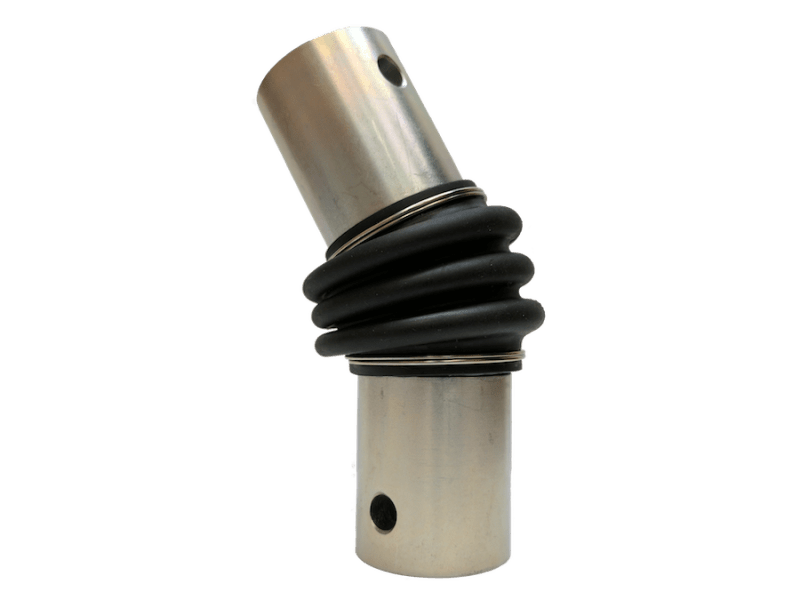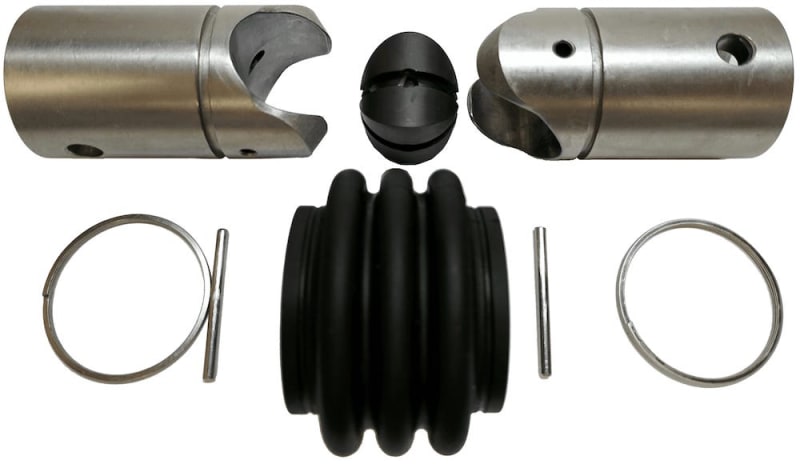The universal joint has been fundamentally the same for the last century ... until now. The new approach uses a square ball and seven other components, which is a stark contrast to the more than 100 parts found in standard u-joints.
The assembly is simplified by replacing many central components with one – a Square Ball. The Square Ball transmits torque from one yoke to another through its square features while simultaneously providing the ability for both yokes to accommodate an angle utilizing the round features. It’s held in a central location of the cylindrically shaped yoke mouth with retaining pins.
A common misconception about the design is that rotational force is placed on the retaining pins. However, the retaining pins simply keep the Square Ball in place, they don’t transfer torque.
The Square Ball Universal JointTM (SBUJ) is comprised of:
• 1 square ball
• 2 yokes
• 2 retaining pins and
• 1 seal
• 2 seal clamps
Advantages
• Fewer parts simplify the u-joint allowing for smoother rotation.
• Maintenance-free due to a true seal that retains lubrication while keeping out containments.
• Larger Load Zone
Universal joints with needle bearings are subject to line load fretting on the raceways from continued vibration, reducing the expected service life. The SBUJ has large load zones that absorb vibrating applications by spreading the same vibrating surface pressure over a larger area.
o A larger load zone withstands vibrating applications by spreading the same vibrating surface pressure over a larger area.
• Low Starting & Operational Torque Resistance
Starting rotational torque of a SBUJ is very low, ranging from 0 to 0.025Nm when the operating angle range is 0 to 25 degrees. Since there are only 3 moving parts, starting torque is consistent.
o Needle bearing u-joints can have over 100 parts per assembly. Tolerance stack-up issues with this many components have inconsistent startup torque values from unit to unit.
o Very low and consistent startup torque values of the SBUJ provide advantages for autonomous steering applications.
• Constant velocity can be achieved when assembled with two properly phased and equal-angled joints, the same as a double Cardan CV.
Application
Current testing has been conducted for steering assemblies. Testing for other applications is under review.
Initial test results had a maximum rotational torque capacity of 250 foot pounds. The recommended maximum intermittent operating torque is 110 foot pounds. The maximum pull apart/tension load at zero degrees equals 1,350 pounds.
SBUJ 263840:
• Square Ball OD = 26mm
• Yoke OD = 38mm
• Maximum Operating Angle (Beak angle) = 40 degrees
Video
Like this entry?
-
About the Entrant
- Name:John Sweetwood
- Type of entry:teamTeam members:John Sweetwood and Rich Perlberg
- Software used for this entry:SolidWorks
- Patent status:pending








